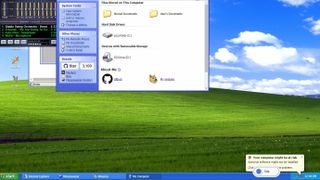Someone Got Windows XP Running on Blockchain

Sometimes people make things just because they can. Does anyone really need a robot that's bad at spoon-feeding its owner soup, an ineffective medication that must be applied "directly to the forehead", or a one-piece swimsuit featuring a grinning Thanos? No. But that didn't stop these oddities' creators, and it didn't stop a developer from making a version of Windows XP run on blockchain, either.
CoinGeek reported earlier this week that a developer called "sh1zuku" managed to make certain parts of Windows XP run on the Bitcoin SV blockchain. That "SV" is short for "Satoshi's Vision," after the pseudonymous Bitcoin creator Satoshi Nakamoto, and the cryptocurrency was created after Bitcoin was hard forked into Bitcoin Cash and Bitcoin Core. (And we thought keeping track of Wi-Fi versions was annoying.)
This version of Windows XP allows people to play Minesweeper, listen to select tracks via Winamp and create something with Paint. Other aspects of the operating system--including File Explorer and Internet Explorer--are essentially limited to a single page. Attempting to do pretty much anything else simply leads to an error; nobody's going to be able to use the site for more than its novelty value.
Other developers have emulated Windows XP via the web before. CoinGeek called particular attention to this project because it demonstrated the utility offered by Bitcoin SV's "ability to routinely handle blocks that are substantially larger than what are found with other blockchains." Bitcoin Core is limited to 1MB blocks; Bitcoin Cash and Bitcoin SV were created specifically to increase block sizes.
We doubt this project will convince anyone of blockchain's potential, but it's an interesting proof of concept that might help people understand that blockchain technology doesn't have to be limited to cryptocurrencies. Besides, if people can get a kick out of a bunch of bad robots, they can probably find the fun in a Windows XP clone as well. It's better than wearing a Thanos-suit.
Stay on the Cutting Edge
Join the experts who read Tom's Hardware for the inside track on enthusiast PC tech news — and have for over 25 years. We'll send breaking news and in-depth reviews of CPUs, GPUs, AI, maker hardware and more straight to your inbox.

Nathaniel Mott is a freelance news and features writer for Tom's Hardware US, covering breaking news, security, and the silliest aspects of the tech industry.
-
TJ Hooker Reply
Basically running something on a (decentralized) virtual machine that's being hosted on all active blockchain nodes. The web page front end would still be hosted on a normal server I believe, but the backend is run on the blockchain VM. That's my understanding anway.Giroro said:What does "running on blockchain" mean? -
bit_user Utterly useless article. As usual, I could tell who wrote it without even looking.Reply
Again, what does this mean? Are you saying that the memory pages are blocks, or something like that? And maybe they get snapshotted, every so often? That would at least make some logical sense, if impractical.TJ Hooker said:Basically running something on a (decentralized) virtual machine that's being hosted on all active blockchain nodes. -
TJ Hooker Reply
I don't really know what in particular is going on with this Windows XP thing, just have a crude understanding of 'running on the blockchain' means in general (or at least on Ethereum).bit_user said:Again, what does this mean? Are you saying that the memory pages are blocks, or something like that? And maybe they get snapshotted, every so often? That would at least make some logical sense, if impractical.
There is an API through which you can interact with the ethereum blockchain to store data, or manipulate data already there. Each of these interactions is expressed as a blockchain transaction and written into blocks. So a developer can code a decentralized application (DApp), which is a smart contract that defines the state of some system and the rules by which this system can be interacted with. They deploy the DAapp by creating a transaction that writes the code of this DApp into the blockchain. From there you create a more conventional webpage front end, which then interacts with the blockchain (or more specifically, the smart contract on the blockchain) by calling functions from the smart contract code via the API. Every ethereum node will compute these interactions (transactions), verify that they conform with the rules of the smart contract, and write the outcome (new state of the system) into a new block. It's this last part (all the nodes computing the transactions) that is referred to as the ethereum virtual machine.
E.g. let's say you make a trading card game. The art assets, GUI, etc. are all stored in a conventional webpage. However, the 'owner' of each card is stored in the blockchain by associating the unique digital identifier for each card with some key. You go on the website and want to trade your card for another (owned by someone else). Both you and other person interact with the web page, which in turn translates these interactions into function calls to the functions written in the smart contract, which ultimately comprises a blockchain transaction, and you sign the transaction using your private key (proving you own the digital asset in question). The VM would execute these transactions in accordance with the code of the DApp, and when the transactions are processed the new block would state that each card now belongs to the new owner.
I'm far from an expert, if it still doesn't make sense it's probably because I don't understand well enough myself to explain it properly. Certainly the actual math/code behind it is beyond me. And I'm more than a little fuzzy on exactly this Windows XP example fits into the explanation I've given above.
Most Popular



